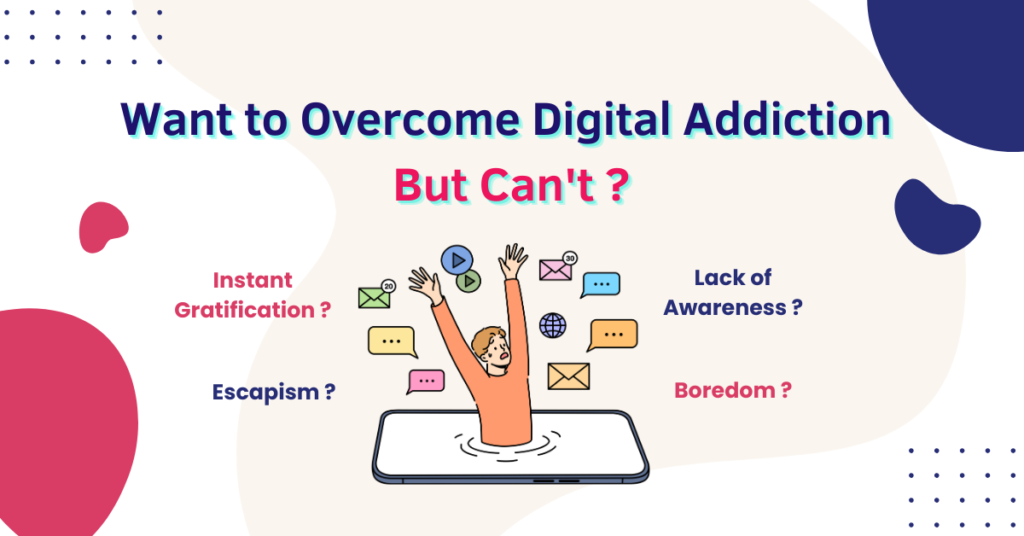
There is a well-known saying about addiction: ‘Addiction doesn’t just harm the person struggling with it; it also hurts their family, children, hopes, and even their future.’ Let’s start with a case study to better understand how digital addiction can negatively affect lives.

“Mr. Manoj (name changed), a 17-year-old male adolescent, was admitted to a psychiatric ward with complaints of mood swings, depressive episodes, irritability, and a lack of connection with his surroundings for several days. He had no prior history of psychiatric illnesses. Upon evaluation, it was revealed that his condition was linked to excessive use of mobile gaming.
Two years ago, Mr. Manoj received a smartphone with internet access and began playing simple video games. Over time, he transitioned to online multiplayer games and gradually increased the time spent on them. He became engrossed in gaming, often playing with a group of friends, and eventually lost control over his usage. This addiction led him to neglect his studies and social activities. He frequently skipped classes, withdrew from family interactions, and spent most of his time isolated in his room, engrossed in gaming.
The virtual world became an escape from real-life challenges. When his parents attempted to limit his phone usage, he exhibited restlessness, irritability, and, at times, verbal or physical aggression. Forced to seek medical help, Mr. Manoj was diagnosed with depressive disorder linked to internet overuse. His treatment included mild antipsychotics, antidepressants, anti-anxiety medications, and supportive care for his nutrition and hydration. During his hospital stay, he underwent individual counseling and was encouraged to participate in physical activities. After two weeks of treatment, Mr. Manoj’s mood showed improvement, and he began to acknowledge the severity of his condition. He was discharged with instructions for outpatient follow-up and continued counseling.”
Insights of the Case
This case highlights how digital addiction can dominate an individual’s life, turning them into a mere tool for digital platforms. It emphasizes the need for timely intervention and a balanced approach to technology use.
The American Psychological Association defines addiction as a dependence on a substance or activity, whether psychological or physical, even when it causes harm. Addiction is not limited to substances like drugs or alcohol; it can also involve behaviors such as gambling, excessive exercise, or compulsive use of digital devices.
Teenagers, who grow up in an environment dominated by smartphones, social media, and video games, are particularly at risk of forming unhealthy digital habits. While some are aware of this issue and wish to change, many find it challenging to reduce their screen time without guidance and support.
As parents, teachers, and caregivers, it is our responsibility to help teenagers navigate these challenges. By understanding the causes of digital addiction and its effects, we can equip ourselves with strategies to assist them in breaking free from these habits. In this blog, we will examine the root causes of digital addiction, its consequences for students, and practical steps to help them regain control over their digital lives.
Understanding Digital Addiction:
Digital addiction refers to the excessive and compulsive use of devices such as smartphones, computers, and gaming consoles, often involving activities like social media, video gaming, and streaming online content. It is characterized by a dependency that persists even when individuals, especially teenagers, are aware of its harmful effects and struggle to reduce their usage.
Causes of Digital Addiction Among Teens:

The causes of digital addiction can be multifaceted, including:
Escapism
Many teens turn to screens as an escape from stress, family issues, or academic pressure.
Peer Pressure:
Social media keeps teens constantly connected with friends, making it hard for them to disconnect.
Instant Gratification:
Likes, comments, and achievements in games provide immediate satisfaction, reinforcing digital habits.
Boredom:
Lack of hobbies or engaging offline activities makes screens an easy distraction.
Lack of Awareness:
Many teens are unaware of the long-term harm caused by excessive screen time.
Role of dopamine:
Addiction develops when the pleasure circuits in the brain get overwhelmed. And this is done because of dopamine (a chemical messenger in the brain that plays a role in many bodily functions, including: Reward and pleasure, movements etc.)
Impact of Digital Addiction on Students:

Before helping teens break the cycle, it is important to understand how digital addiction affects their lives:
Decline in Academic Performance:
Excessive screen time leaves less room for study, concentration, and productive habits.
Mental Health Issues:
Teens addicted to devices are more prone to anxiety, stress, loneliness, and sleep disorders.
Physical Health Problems:
Sitting for long hours leads to poor posture, eye strain, and unhealthy lifestyles.
Impaired Social Skills:
Constant virtual interaction can reduce face-to-face communication skills.
Behavioral Changes:
Mood swings, irritability, and frustration often emerge when devices are taken away. If left unaddressed, these effects can severely impact a teen’s future development and well-being.
Practical Ways to Help Teens Break Digital Addictions:

Here are some actionable steps for parents and educators, can take to help teens regain control over their digital lives:
1. Start with Open Conversations:
Instead of scolding or blaming, sit down and have an honest, non-judgmental discussion about digital habits. Understand their struggles and make them feel heard. Share stories or examples of how balance can improve their life.
2. Set Realistic Goals:
Encourage teens to reduce screen time gradually rather than expecting immediate changes. For instance, set a daily screen-time limit or introduce short device-free periods, such as during meals or before bedtime.
3. Promote Alternative Activities:
Help teens replace screen time by exploring new hobbies that engage their minds and bodies. Encourage sports like swimming or cycling for physical and mental health, creative outlets such as painting or music, and activities like reading, meditation, or journaling to promote relaxation and personal growth.
4. Set Boundaries and Create Tech-Free Zones:
Establish a no-device rule during family dinners and in bedrooms at night. Set specific hours for gadget use and ensure the rules are followed consistently.
5. Model Healthy Digital Habits:
Teens are more likely to follow the example set by adults. Parents, teachers, and mentors should reduce their own screen time when interacting with children and avoid distractions, such as checking notifications, during family or quality time.
6. Educate About the Consequences:
Teens often lack awareness about the impact of excessive screen use. Share real-life stories or research to illustrate how digital addiction can harm physical and mental health. Highlight how reducing screen time can lead to better sleep, improved grades, and stronger friendships.
7. Encourage Offline Social Connections:
Create opportunities for teens to connect with friends and family in person. Plan activities like outings, game nights, or community events that encourage engagement without screens.
8. Use Technology to Fight Technology:
If teens find it difficult to manage their screen time, consider using tools like screen-time monitoring apps to promote accountability. Apps such as Rescue Time, Quality Time, AppDetox, Google Family Link, or Forest can help track usage and encourage healthier digital habits.
When to Seek Professional Help:

If teens display severe signs of addiction, such as withdrawal, focus issues, or mental health problems, seek professional help. A counselor or psychologist can offer strategies to reduce screen time, address emotional issues contributing to the addiction, and provide support for both teens and their families.
Final Thoughts:
Breaking digital habits takes time, patience, and support. Teens must learn that technology is a tool, not a trap. By setting healthy boundaries, encouraging offline activities, and promoting balance, we can help them regain control. As educators, parents, or mentors, the goal is not to eliminate technology, but to teach mindful, purposeful use. Together, we can help teens build healthier habits and brighter futures.
Shapeinlife’s Tip:
Small steps can make a big impact in overcoming digital addiction! Encourage teens to start with just 30 minutes of screen-free time each day. This simple habit can be the first step toward breaking free from screen addiction and rediscovering the joys of the real world—spending quality time with family, exploring hobbies, or enjoying nature. Celebrate their small victories and emphasize the importance of balance. With consistency and support, these small changes can pave the way to a healthier, more mindful relationship with technology.

03gefr
Pingback: Better Sleep for Students: How It Boosts Grades & Brain
cannabis delivery california trusted source
Pingback: Nuclear Family Parenting: Balancing Bonds and Growing Up